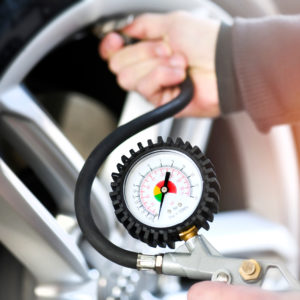CAUTION: Checking tire pressure without a gauge is not recommended. Tire gauges are very affordable and can be easily purchased from your trusted parts store. Information in the following article should only be considered in the rare scenario where using a tire gauge to measure tire pressure is impossible. Even then, be warned that tire pressure estimates without an actual tire gauge will not be accurate.
The tire pressure indicates how well-inflated a tire is. Tires must have a sufficient amount of air inside them to provide extra cushioning without making them too heavy. Typically, drivers can measure the air pressure in a tire by using a gauge.
But what if you don’t have a tire pressure gauge? Are there other ways to determine whether a tire has enough air to safely use?
How to Check Tire Pressure Without a Gauge: Easy Methods
Yes, you can check a vehicle’s tire pressure without using a gauge. Some methods you can try include doing a cargo test, pressing the tire, conducting a trail comparison, or visually inspecting the tire.
Again, be warned that none of these methods accurately measure tire pressure. Never rely on tire pressure estimates without a tire pressure gauge. Only consider doing these tests in the rare case that getting a tire pressure gauge is impossible.

Cargo Test
A simple way to check the tire pressure is to load your vehicle full of cargo. Distribute the load evenly. If one or more of your vehicle’s tires lack air pressure, the weight will lean toward that side.
During the cargo test, the extra load places more weight on the tire with less air pressure, pushing it down and making the distribution of cargo lopsided.
Press the Tire
Another way to test the air pressure of a tire without a tire pressure gauge is to press down on it with your hands. Grab the sidewalls of the tire and press your weight on it.
A properly inflated tire with the ideal air pressure should be firm. If the tire feels spongy or if the tire feels too hard, it is either underinflated or overinflated.
Trail Comparison
Covering tire treads with ink and driving the vehicle on a flat road is a good way to determine whether or not the tires are well-inflated.
Observe the trail left by the ink. A tire that lacks pressure will leave telltale streaks, while a well-inflated tire will not.
Visual Inspection
Closely examining the tires should help you tell if a tire is underinflated or overinflated. If the tires bulge slightly, dropping by more than a centimeter, it’s likely the tire pressure is too low.
Conversely, if the tire is bulbous and looks ready to burst, the tire pressure is too high. You won’t be able to get an accurate measurement with a simple visual inspection, which is why this method is best used with other methods.

Why Is Tire Pressure Important?
The air pressure of a tire determines how inflated it is. The average tire pressure of a vehicle varies depending on its size.
Typically, smaller vehicles have a tire pressure of 30 PSI, while medium vehicles have a pressure of 36 PSI. Larger vehicles have an average tire pressure of 42 PSI. If the tire pressure drops below or rises above these levels, it can cause serious problems.
Normally, checking your vehicle’s tire pressure is a simple process. All you have to do is use a tire pressure gauge. Tire pressure sensors can also alert you when the pressure drops below recommended levels.
However, you might not have a tire pressure gauge on hand when you need it. Likewise, tire pressure sensors can become faulty. That’s why it’s important to know how to determine pressure without them.
Can You Drive with Low Tire Pressure?
You can, but it’s a terrible idea to drive a vehicle with low tire pressure. Driving a vehicle with underinflated tires causes many problems for your ride.
For example, low tire pressure negatively impacts performance by reducing traction and grip.
Not only does the diminished traction and grip make your vehicle slower, but you’ll also be more likely to get into accidents. Braking becomes much slower and harder to control. On top of that, tires with low pressure are also more prone to overheating and getting ruptured.
Signs Your Tire Pressure is Too Low
Here are some of the biggest indicators that your vehicle’s tire pressure is too low:
- Poor handling
- Cracked tires
- Excessive steering wheel vibrations
- Activated warning lights switch
Can You Drive With High Tire Pressure?
No, it’s not recommended to drive a vehicle with high tire pressure, which typically occurs when a tire is overinflated. An overinflated tire is just as dangerous as an underinflated tire.
Overinflated tires are more likely to burst. They become significantly easier to puncture because the increased pressure changes the tire’s shape. Overinflated tires also wear out quickly, and their bulbous shape decreases their traction.
Signs Your Tire Pressure Is Too High
Here are some of the warning signs your vehicle’s tire pressure is too high:
- Bumpier rides
- Ineffective anti-lock braking system
- Poor traction
- Tires wear unevenly
Any information provided on this Website is for informational purposes only and is not intended to replace consultation with a professional mechanic. The accuracy and timeliness of the information may change from the time of publication.
































